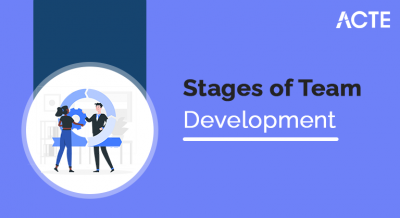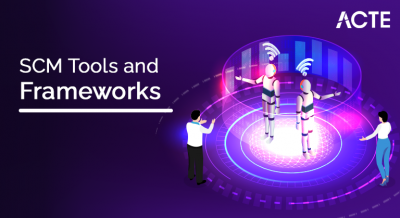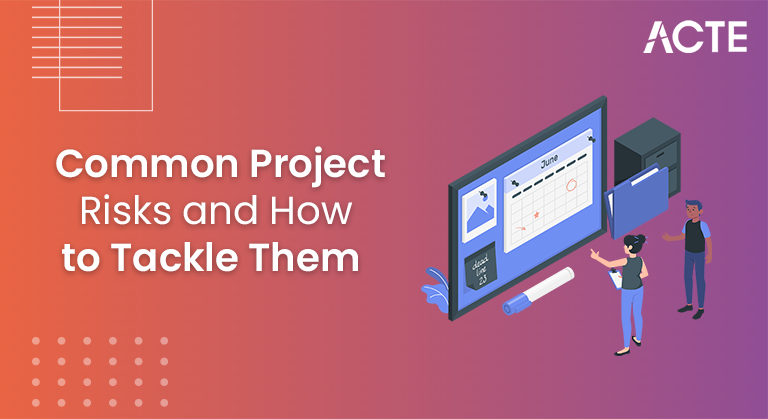
The technological aspect of running a project is a complex deliverable because there is a high turnover of new and advanced technologies.
- Introduction:
- Tools
- Breaking Opportunities and Impact
- Features / Characteristics
- Types/methods
- Examples
- How to tackle them
- Why it is needed and important?
- Trends
- Benefits
- Conclusion
- Risk management in project management begins with project risk identification.
- There is no way to account for all potential project risks, so we need to focus on finding the major impacts on a few important research methods. These include:
- Talk to participants to find out about risks that have affected the organisation or previous group project.
- Identify external risks using a situation analysis framework such as PESTEL (Political, Economic, Social, Technical, Environmental, Legal).
- Review your project planning documents to see project risks.
- Create a short list of project risks, good and bad, and plan how the project will navigate the potential outcomes.
- As the project progresses, a more efficient phase of project risk management begins.
- As long as the accident does not happen, the project manager can simply monitor the risk until the project ends or the risk expires. This should be done within the project management dashboard.
- In the event of a known project hazard during a project, the project manager should use measures developed during project planning to minimise adverse effects and maximise positive outcomes.
- Project risks can be positive or negative for a project. With good planning, they can be even better; without it, they can be even worse.
Introduction:
A project risk is an uncertain event that may or may not occur during the project. Contrary to our everyday perception of what “risk” means, project risk can have a negative or positive impact on the progress of a project. Imagine a summer that will be extremely hot and sunny. For a team working on a project to introduce a new ice lolly, this could be a risk with a positive outcome. For the team organising the First Snow Recording Competition, the opposite may work.
Project risk
- Data available
- Quality and reliability of data
- Data integrity
- The next step in analysing high-risk risk is to analyse the potential and impact of risks on the Perform Quantitative Risk.
- Identification of a risk response that requires urgent attention
- Identify the risk exposure to the project
- Identify the risk impact on the project objective
- Determine the cost and schedule the amount that may be required in the event of an accident
- Identify risks that require extra attention
- Negotiation
- Cost and time
- Delphi Technology
- History Records
- Expert judgement
- Expected monetary analysis
- Monte Carlo Analysis
- Decision tree
Tools:
Other tools that can be used to analyse quality risk include:
Opportunities and Impact Matrix
The matrix helps identify those risks that require immediate response. Many companies have a fixed template for this matrix and project managers can use those templates. The use of standard matrices makes the list of matrices more duplicate between projects.
Risk Data Quality Assessment
Data is collected on identified risks. The project manager will endeavour to determine the accuracy of the data to be analysed in order to complete the risk analysis. For each Risk, In Assessing Risk Data Quality, a project manager needs to determine:
Risk understanding level
Do Analysis of Multiple Risks
Breaking Opportunities and Impact
Other strategies for determining quantity of risk and risk factor include:
Features / Characteristics:
Time-based
In this case, the risk of risk occurring at the beginning of the project is very high (due to an unknown factor), and it decreases as the project progresses. Conversely, the impact (cost) from a potential risk is low in the beginning and high in the end.
Dependence
Within a project, many tasks and deliveries depend on each other. This delay in these activities will have the effect of cascading on other related activities, and the result may be a domino effect.
It depends on the size
The relationship between probability and impact is not online in this scenario, and the magnitude of the risk makes a big difference. For example, consider the risk of spending $ 1 on a 50/50 chance of winning $ 5 compared to the risk of spending $ 1000 on a 50/50 chance of winning $ 5000. Since the risk of loss is the same in both cases (50%), the cost of loss is much higher in the latter case.
Value-Based
Risks may be influenced by personal, business or cultural values. For example, completing a project on time may depend on the time of year and the nationality or religious beliefs of the task team. Projects carried out in international arenas where multiculturalism is involved may be at greater risk than in one place with the same staff.
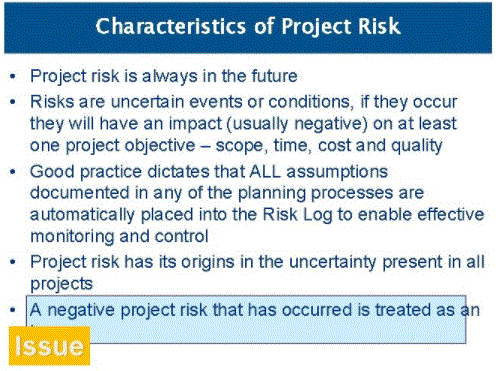
- IT system risk
- Risks of human use and direct process
- The dangers of using people and indirectly processing
- Risk of financial power
Types/methods:
Other common project risks include:
1. Technical hazard
The technical aspect of running a project is a complex one that can be brought about because of the high benefits of new and advanced technology. The technical aspect of the project poses a significant risk to data security, organisational services, compliance and information security. The risks associated with technology are very challenging because implementing new IT systems often requires training of new employees and software acquisition.
2. The danger of communication
Effective and timely communication is an important operational goal that you should be aware of when managing a project. Setting up meetings with stakeholders, such as project providers, helps you keep track of any changes, redesign tasks and promote a cohesive team environment. With all the communication channels and gadgets we have, team members sometimes overlook the key components of effective communication, leading to data loss or incorrect information and ultimately disruptive projects.
3. Risk of wide rise
Uncontrolled and unauthorised change in the initial project scope may result in additional costs for additional features, products or services. Almost all projects face this risk, and sometimes it poses an irreversible challenge because some of the additional tasks are important to the project and are desirable for the success of the project.
4. Risk of cost
Lack or mismanagement of project finances due to rising budgets or other constraints poses a threat to project completion. If the cost of a project is higher than the budgeted expenditure, the risk may shift to other activities and categories of staff. The reduction in funding may also contribute to the emergence of a broader risk.
5. Occupational hazard
A project may stop or end if there is an improper implementation of important tasks and important processes such as production or purchase. Risk may result in direct or indirect losses due to lack or failure of quality, quantity or strategy. Depending on the type of project, the operational risks are:
6. Health and safety hazard
Health and safety is a type of risk that may violate company compliance rules. An entity should regularly monitor and evaluate its own health and safety standards in order to identify potential risks to a company’s losses or penalties. Risk can also lead to employee or customer health problems where the company’s reputation may be compromised. Managers are responsible for establishing continuous health and safety monitoring on the company’s premises and its products or services.
7. Risk of skills service
Utilising internal staff is a major risk of the project because sometimes project activities are moved by different waves in different areas, requiring the presence of internal staff. Wave waves become a source of stress. Staff inefficiency in various project phases is another risk that may contribute to the additional costs of staff retraining or referrals.
8. Occupational hazard
If a project is not possible to achieve the results as intended, there is a significant operational risk. Risk has a natural impact on the overall performance of a business. Such a crisis can lead to increased need for money, potential fines for poor performance, and increased performance for competitors.
9. Market risk
If a project fails to meet the stated outcomes, market risk may occur. Competitors may take the opportunity to cripple the business and remove it from the market. Another market risk may occur in the goods and foreign markets, which may not be in favour of initial project estimates. Liquidity, credit and flexibility in interest rates also serve as a strong market distraction in project product sales.
10. External risks
An adverse event beyond the control of project managers is a potential risk. Such dangers are manifest in a variety of ways, including terrorism, hurricanes, floods, destruction of property, earthquakes, and civil unrest. The project may stop or stop when such events occur. By taking appropriate precautionary measures, organisations can prevent significant damage or loss caused by unforeseen external risk.
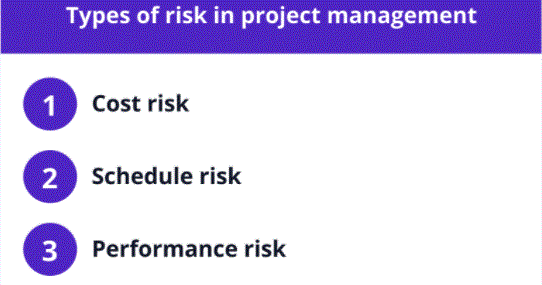
Examples:
An accident is a chance, high or low, that any accident will injure a person. For example, working alone away from your office can be dangerous. The risk of personal injury may be high. The power cord is dangerous.
Avoid: Change your strategy or plans to avoid risk.
Reduce:Take the initiative to reduce the risk. For example, operating procedures and equipment designed to reduce occupational safety hazards.
Transmit: Transfer risk to third party.
Accept: Decide to take risks.
How to tackle them:
1. Six guidelines for project risk mitigation
Uncertainty is common in parts of major projects and most of the technology. Risks often put an organisation in jeopardy because of a failure or intervention to reduce project risk and emergency measures. Here are six steps to reduce project risk that will keep your project moving.
2. Prioritise and report risk
Because risk has a wide range of effects on a project, select and develop an effective mitigation strategy that can result in very high losses. It is prudent to set the scale and weigh the risks to focus their views from the highest threats so that in-depth discussion with the project management committee can focus on what they are saying. Reporting risks also helps project managers track all activities, providing a platform for accountability.
3. Link the probability of each accident and its effect
Each risk can have a low, medium or high impact. As a group, you can build a matrix of opportunities that measure risk against impact. Such a matrix or application will assist in decision-making regarding the likelihood of an accident compared to its outcome in order to achieve timely measures. Linking risk to potential impact is also important because it provides management with project activities with the goal of effective monitoring.
4. Develop and develop responses to risk
By completing a project risk response strategy, you avoid potential threats that may not occur or minimise adverse effects if the problem is unavoidable.
5. Have an emergency plan for each accident
In the event of an accident, the team should have a fast and reliable emergency plan ready to operate. The plan should minimise or prevent injuries and prevent further disaster. To bring all stakeholders to the planning and implementation of an emergency plan. The emergency plan should seek to answer the following questions:
6. Record and track hazards next to related activities
Recording risks according to their level of related activity or process level helps managers track potential risks. It is important to record the risks identified in the disaster register and keep them on a central project server throughout the project. Because each task can have a different person to monitor, it is easier to track each potential risk and improve response. Records also allow participants to focus on the current situation regarding project progress.
Why it is needed and important?
Risk identification enables businesses to make plans to reduce risk events before they occur. The purpose of this measure is to identify any risks that may affect the company’s operations, such as lawsuits, theft, technical breaches, business collapse, or even a Category 5 storm.
Analyzing project risk is important because it helps project managers identify weaknesses, strengths and potential opportunities during or after project completion. Aims to reassure participants that program objectives will be achieved despite the challenges.
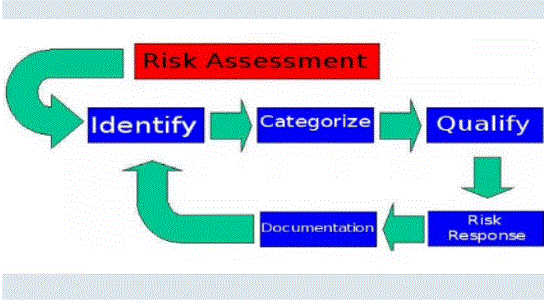
Trends:
The following are common practises among successful project managers in project organisations.
Project Marketing
Project marketing and project management are often discussed and seen as independent fields. This is because project managers often tolerate the marketing role in the marketing team, often unaware of what is going on with the project.
Early disaster management
All project managers today understand the importance of risk identification and management in determining project success. The more risk identified by the project manager and his or her team, the easier it is to develop risk management strategies, thus increasing the chances of project success. The key question is: “At what point in the project do we start to identify risks?”
Industrial balancing is important
Another rising trend among successful project managers is the need for organisations to measure using industry standards rather than the success of the previous organisation. Competition is global and, in order to maintain competitiveness in the industry, project managers compare their success with generally accepted industry standards.
Leaders and not managers
One of the most researched topics you will find online and other articles to manage differences between leaders and managers. The tendency that arises in project management is that organisations and project team members seek additional leadership skills from their project managers. Since the project manager’s responsibility is to ensure that the project is completed to achieve all objectives within the designated project boundaries, the project manager is often concerned about the success of the project.
Benefits:
The main advantage of Leon risk assessment is that it empowers the full risk analysis to take and deal with risks. In the analysis, the team is classified as risk based on probability and impact. Risks they consider significant are then measured in terms of cost and / or time to determine the most effective ways to deal with them. It is useful for risk analysis, but it cannot be done without risk identification.
One of the benefits highlighted by Leon, who he believes will be particularly helpful to his team, is that risk identification requires the scope of the project to be established early. Project team members sometimes wonder if the people applying for the project have considered their application. Genuine involvement in risk identification ensures that this will happen. All potential risks cannot be identified if every application is known and scrutinized.
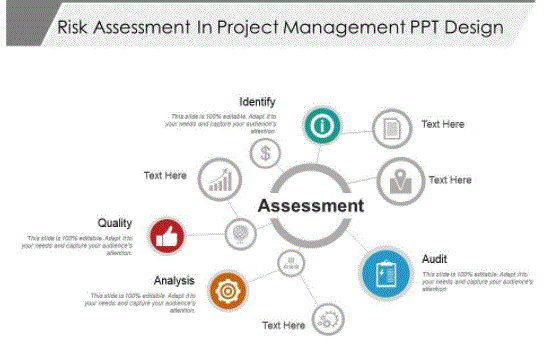
Conclusion
Project management is not what it seems to be – it is more than that. It is a skill that requires time, patience and perseverance. It requires you to constantly analyse the obstacles and failures and apply the lessons you learn. If you focus on each challenge and find ways to deal with it before you start a project, then you will be able to successfully manage the project.




